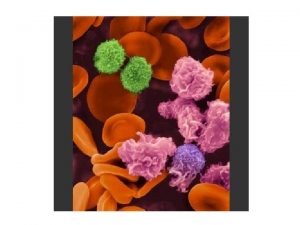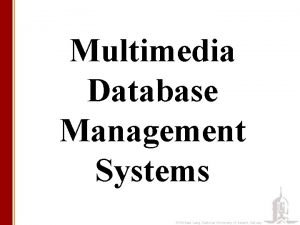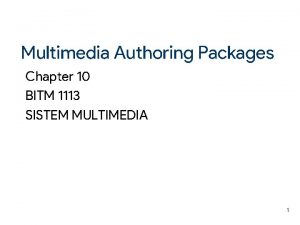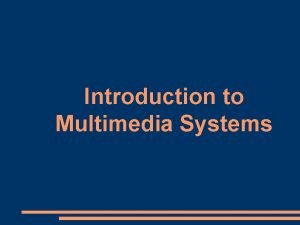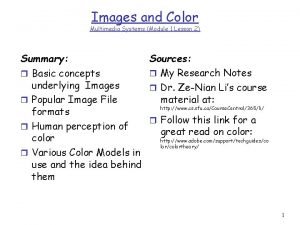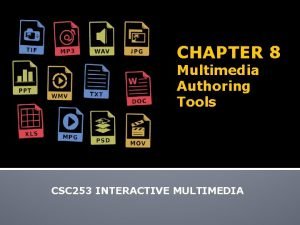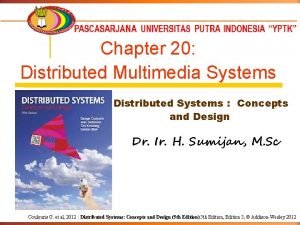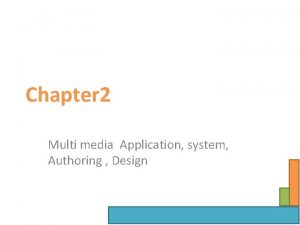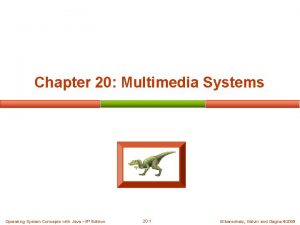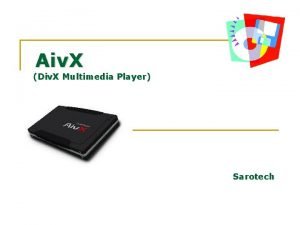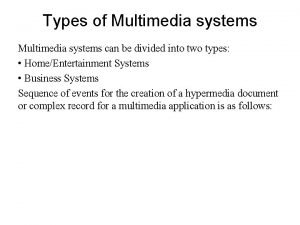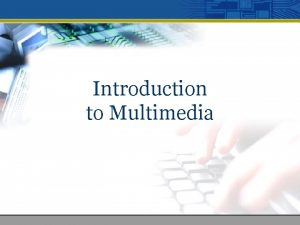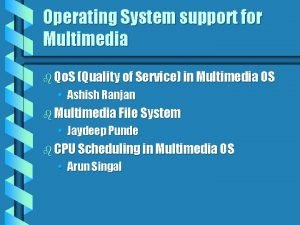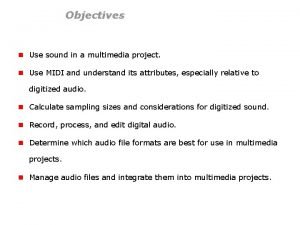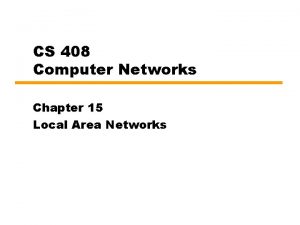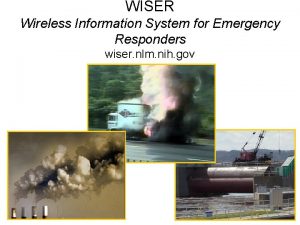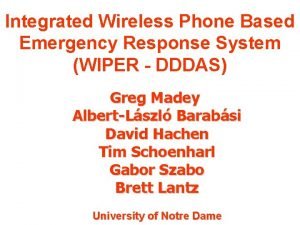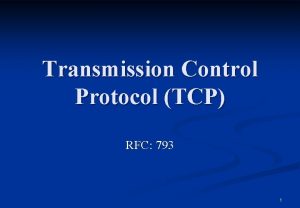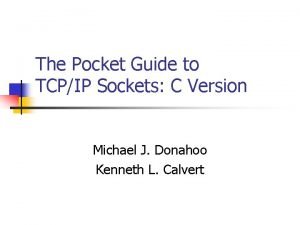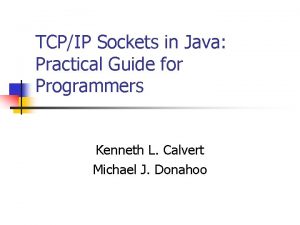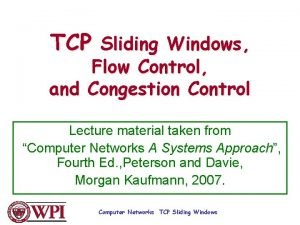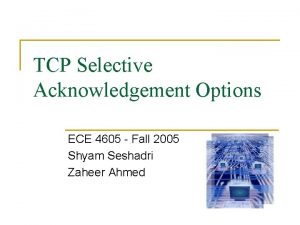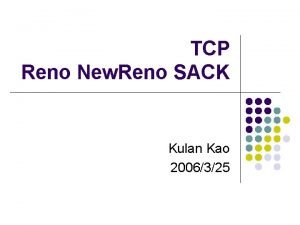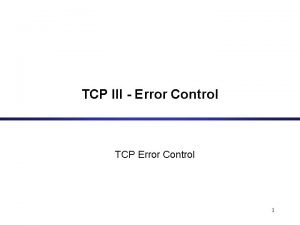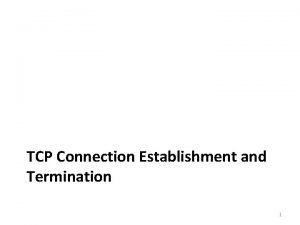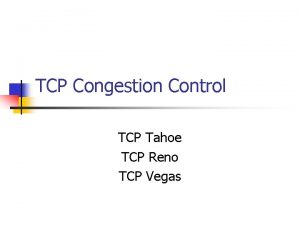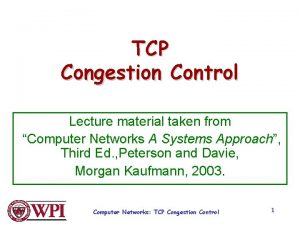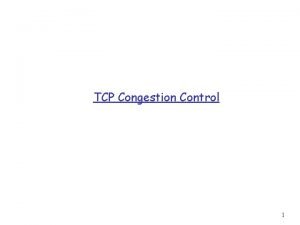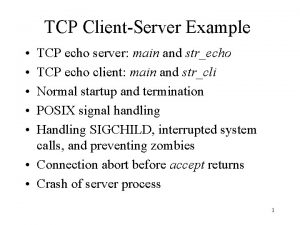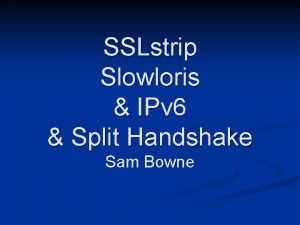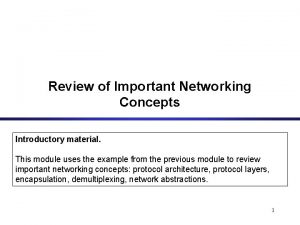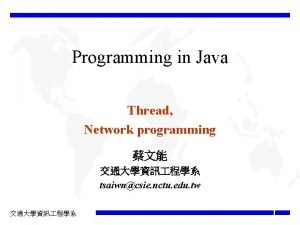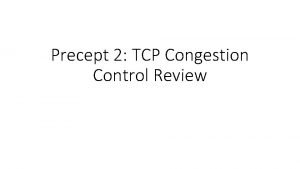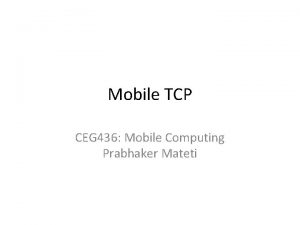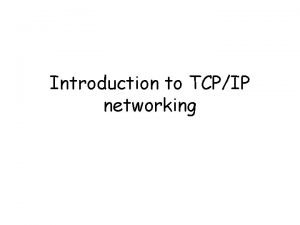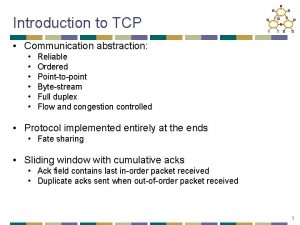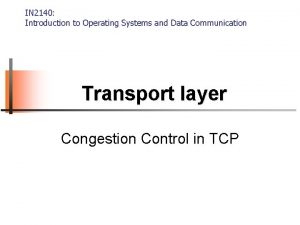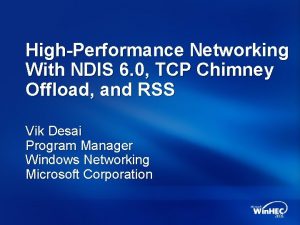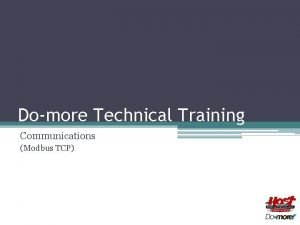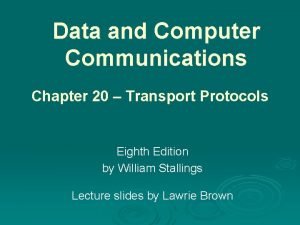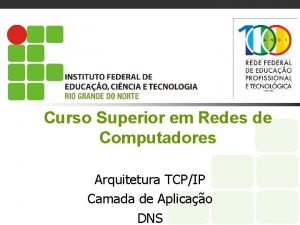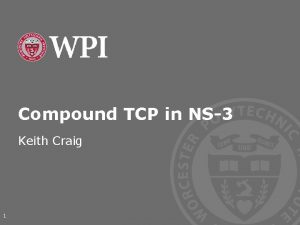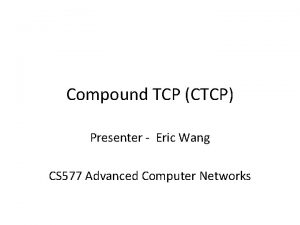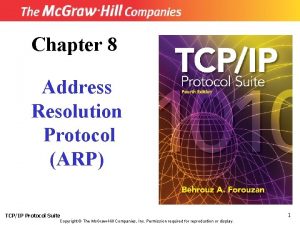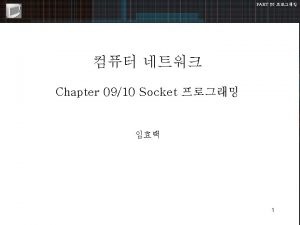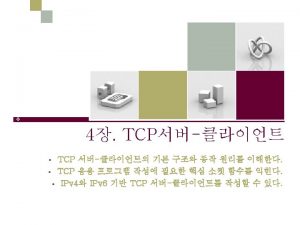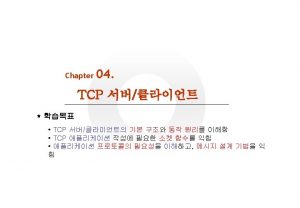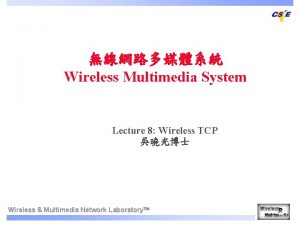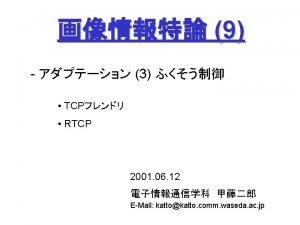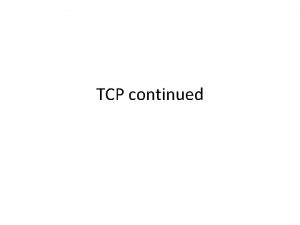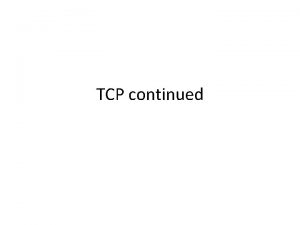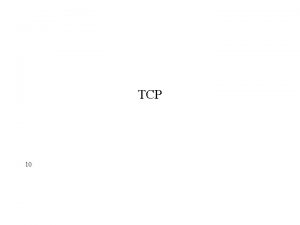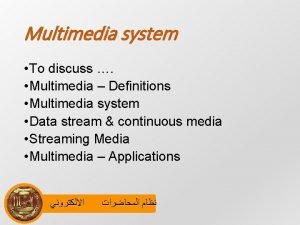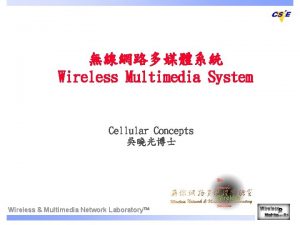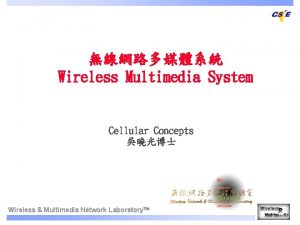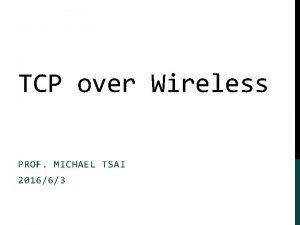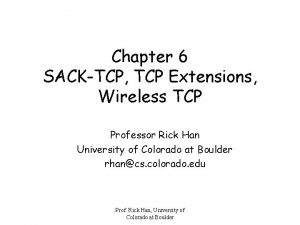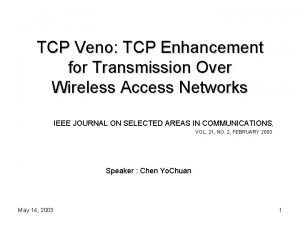Wireless Multimedia System Lecture 8 Wireless TCP Wireless
















![Reading w [Balakrishnan 95], Harri Balakrishnan, Srinivasan Seshan, Elan Amir and Randy H. Katz, Reading w [Balakrishnan 95], Harri Balakrishnan, Srinivasan Seshan, Elan Amir and Randy H. Katz,](https://slidetodoc.com/presentation_image/51287c1c23e29296cc222662cf3692fc/image-17.jpg)































![Main Conclusions of [Balakrishnan 97] w Simple link layers do not quite work • Main Conclusions of [Balakrishnan 97] w Simple link layers do not quite work •](https://slidetodoc.com/presentation_image/51287c1c23e29296cc222662cf3692fc/image-49.jpg)



![inter-arrival jitter w [RFC 1889] The difference D is packet spacing at the receiver inter-arrival jitter w [RFC 1889] The difference D is packet spacing at the receiver](https://slidetodoc.com/presentation_image/51287c1c23e29296cc222662cf3692fc/image-53.jpg)


















- Slides: 71

無線網路多媒體系統 Wireless Multimedia System Lecture 8: Wireless TCP 吳曉光博士 Wireless & Multimedia Network Laboratory

Coming Issues SIP Energy Efficient The Life After 3 G Ad hoc Network Wireless TCP Mobile IP Mobile Multicast 1 Wireless & Multimedia Network Laboratory

Mobile IP Forwarding address Home address 128. 8. 128. Y 132. 4. 16. Z 132. 4. 16 R R 128. 8. 128 2 Wireless & Multimedia Network Laboratory

Cellular IP 3 Wireless & Multimedia Network Laboratory

Wireless TCP w TCP turned to perform well in traditional network where the packet losses occur mostly because of congestion. w In the wireless environment • • Non-congestion losses caused by wireless link The degraded performance of TCP is mostly due to mistaking wireless losses for congestion. Ethernet Base Station Mobile Host 4 Wireless & Multimedia Network Laboratory

SIP Protocol 5 Wireless & Multimedia Network Laboratory

Mobility support 6 Wireless & Multimedia Network Laboratory

Mobile Multicast w w Mobile Network~ Mobile IP w Resource Conservations~ Single Copy in…Multicast IP Application Requirements: updates to replicated databases, Interprocess communication among cooperating processes 7 Wireless & Multimedia Network Laboratory

Mobile Multicast One to Many Mobile Multicasting Services 8 Wireless & Multimedia Network Laboratory

Internet Interconnection and Mobile IP w DSR support the seamless interoperation between an ad hoc network and the Internet Bridge Ethernet 128. 97. 92 Router 128. 97. 92. 68 Ethernet 128. 97. 84 Gateway Node 9 Wireless & Multimedia Network Laboratory

Ad hoc & Cellular System D 3 Cell S 3 S 1 BS D 1 BS S 2 D 2 10 Wireless & Multimedia Network Laboratory

Qo. S Support for an All-IP System Beyond 3 G 11 Wireless & Multimedia Network Laboratory

BRAIN w Broadband Radio Access for IP-Based Networks • • • Cellular systems, fixed networks, and wireless LANs Personal mobility, adapted for the terminal and link bandwidth End-to-end Qo. S A new Qo. S model for applications (BRENTA) The radio link improvements w IP-aware RAN (Radio Access Network) • • Better support to IP applications IP infrastructure will be widely available w Protocol must be redesigned • • • Resource Management Terminal mobility RAN and terminal must have IP Stack Wireless & Multimedia Network Laboratory 12

BRAIN (Broadband Radio Access for IP-based Network) 13 Wireless & Multimedia Network Laboratory

Energy and Power Efficient w As wireless networks become an integral component of the modern communication infrastructure, energy efficiency will be an important design consideration due to the limited battery life of mobile terminals. w This paper presents a comprehensive summary of recent work addressing energy efficient and low-power design within all layers of the wireless network protocol stack. Application Energy Efficient OS, Middle. Ware RTP, TCP, UDP RSVP IP, Mobile IP Wireless Network Layer Low-power Clustering(optional) Data Link MAC Radio Wireless & Multimedia Network Laboratory 14

Agenda w Basic TCP w Impact of Mobility & Wireless on TCP performances w Solutions for Wireless TCP w Midterm (next week) 15 Wireless & Multimedia Network Laboratory
![Reading w Balakrishnan 95 Harri Balakrishnan Srinivasan Seshan Elan Amir and Randy H Katz Reading w [Balakrishnan 95], Harri Balakrishnan, Srinivasan Seshan, Elan Amir and Randy H. Katz,](https://slidetodoc.com/presentation_image/51287c1c23e29296cc222662cf3692fc/image-17.jpg)
Reading w [Balakrishnan 95], Harri Balakrishnan, Srinivasan Seshan, Elan Amir and Randy H. Katz, “Improving TCP/IP Performance over Wireless Networks”, ACM Mobicom 95 w [Balarkrishnan 97], Harri Balarkrishna, Venkat N, Padmanabhan, Srinivasan Seshan and Randy Katz, “A Comparison of Mechanisms for Improving TCP Performance over Wireless Links”, IEEE JSAC 97. w Reference: Ka-Cheong Leung and Victor O. K. Li, “Transmission Control Protocol(TCP) in Wireless Networks: Issues, Approaches, and Challenges”, IEEE Communications Survey 2006 Wireless & Multimedia Network Laboratory 16

Mobility in Wireless LANs: Basestation as Bridges Ethernet 128. 97. 92 Bridge Ethernet 128. 97. 92. 72 128. 97. 92. 5 Router 128. 97. 84. 1 128. 97. 92. 68 Ethernet 128. 97. 84 Fails! 128. 97. 92. 68? ? w w Basestations are bridges(layer 2) – i. e. they relay MAC frames • Smart bridges avoid wasted bandwidth Works the within an ethernet(or other broadcast LAN) • Fails across network boundaries, and in switched LANs(e. g. ATM) Wireless & Multimedia Network Laboratory 17

Qo. S and Multimedia Traffic Support Application OS, Middle. Ware RTP, TCP, UDP Adaptive Algorithm by Qo. S Requirement RSVP IP, Mobile IP Wireless Network Layer Clustering(optional) Data Link MAC Mobility Unpredictable channel by Qo. S Information Radio 18 Wireless & Multimedia Network Laboratory

Background w w With the growth of wireless device, wireless network access will become popular, but… Import the protocol from the wire network to wireless network… Packet losses occur in wireless due to the lossy links, not network congestion In traditional TCP, it can not distinguish the difference between that lossy link and network congestion 19 Wireless & Multimedia Network Laboratory

Characteristics of Wireless & Mobility w Limited Bandwidth • Small frame sizes (MTU) to keep latency small w High bit error rates • Small frame sized to keep packet loss probability small w Time varying bit error rate • Fading, frequency collisions etc. w Qo. S (loss rate, delay) degradation during hand-off • • Due to network layer rerouting Due to link layer procedures w Qo. S degradation after hand-offs • • Lack of resource at new basestation Less optimal route 20 Wireless & Multimedia Network Laboratory

Basic End-to-End Control (Transport) 21 Wireless & Multimedia Network Laboratory

Typical loss situation 22 Wireless & Multimedia Network Laboratory

UDP (Connectionless, Unreliable) Possible Multicast, Real Time Traffic, TCP-Friendly 23 Wireless & Multimedia Network Laboratory

Impact on Connectionless, Unreliable Transport Protocol w Example: effect on UDP applications w Increase in end-to-end packet losses • • Error on wireless link Packet loss during hand-offs w Drop in application throughput • • Errors on wireless link Packet loss during hand-off w Pauses in interactive applications • • • Burst errors on wireless link Packet loss during hand-off Delay increase due to buffering & re-sequencing during hand-offs w Application level impact is much more complex! 24 Wireless & Multimedia Network Laboratory

TCP (Connection Oriented, Reliable) Data Transmission, WWW, flow control, error control 25 Wireless & Multimedia Network Laboratory

TCP and Congestion Control w Terms: • advertised window • • congestion avoidance congestion window 26 Wireless & Multimedia Network Laboratory

TCP Basics w Sliding window protocol: Go-Back N ARQ • • w s Window is max number of outstanding un. ACK’ed bytes in network Cumulative acknowledgement scheme (original TCP) • • w Ack’s all bytes up through n Piggybacked on data packets in reverse direction Control of sender’s window size • • w Transfers a byte stream in “segments”, not fixed user blocks, logical timer associated with each segment that is sent 32 -bit sequence number indicated byte number in stream Min (receiver’s advertized window, congestion window) Three goals s Flow control to avoid receiver buffer overflow s Congestion control to react to congestion in network layer & below s Congestion avoidance Segment loss is assumed to be a result of congestion in routers • Reasonable for wired network since BER on fiber is better than 10 -12 Wireless & Multimedia Network Laboratory 27

TCP’s End to End Congestion Control w Window-based congestion control • • Cwnd: congestion window size Ssthresh: slow start threshold (for slow down of increase) w Timeout is an indicator of segment loss w Timeout value • Using estimated average of ACK delay and expected deviation w On timeout • • Segment is assumed lost and is attributed to congestion One-half of current window Is recorded in ssthresh Cwd is reduced to 1 Timeout value is increased in case packet was delayed 28 Wireless & Multimedia Network Laboratory

TCP’s End-to-end Congestion Control w On new ACK • • Everything okay, so allow larger congestion window Two ways of increasing cwnd s Phase 1: slow start until cwnd <= ssthresh – Fast (exponential) increase of cwd s Phase 2: congestion avoidance – Slow (additive) increase of cwnd w Duplicate ACKs • • • Two causes: lost segment, misordered segment >=3 duplicate ACKs in a row are a good indication of a lost segment but data is still flowing Fast Retransmit and Fast Recovery s s s Missing segment is retransmitted without waiting for timeout One half of current window is recorded in ssthresh Congestion avoidance is done but not slow start Wireless & Multimedia Network Laboratory 29

Challenges of Mobility and Wireless on Network Performance TCP Performance 30 Wireless & Multimedia Network Laboratory

The Problem w In Wireless and mobile networks, segment loss is likely not due to congestion • • Packet corruption due to high BER on wireless link (noise, fading) Packet delay and losses during handoffs w But, TCP invokes congestion control nevertheless w Mistaking wireless errors and handoffs for congestion causes • • Significant reductions in throughput (window size decreases, slow start) Unacceptable delays (low resolution TCP times ~500 ms, back-off) Packet loss due to congestion FH Packet loss due to corruption and handoffs, excessive Delay due to handoffs BS MH 31 Wireless & Multimedia Network Laboratory

Example graph cwin<=ssthresh slow start cwin>ssthresh congestion avoidance 32 Wireless & Multimedia Network Laboratory

Slow Start of TCP Reno window w w’ ssthreshold w/2 w’/2 time SS timeout AIMD ssthreshold : slow-start threshold Wireless & Multimedia Network Laboratory 33

Congestion Avoidance of TCP Reno window TDACK time SS CA SS: slow start CA: congestion avoidance Wireless & Multimedia Network Laboratory Fast retransmission / Fast recovery 34

Fixes? w w Fix TCP • • TCP really a hack in many ways. . • Move away from cumulative ACK Fix lower layer to make TCP work better • w Separate congestion control from error control Improve the wireless link Use something different • • Something totally new Something different for the wireless part 35 Wireless & Multimedia Network Laboratory

Normal TCP 36 Wireless & Multimedia Network Laboratory

Fast-Retransmit Scheme 37 Wireless & Multimedia Network Laboratory

Solutions for WTCP (I) Split the connection into two parts 38 Wireless & Multimedia Network Laboratory

Split Connection Approaches w Main Idea: split MH ↔ FH connection into two MH ↔ BS & BS ↔ FH • • • Separate flow control and reliable delivery mechanisms Intermediate higher layer agent at the base-station Session layer hides the split connection w Two approaches: • Both FH ↔ BS & BS ↔ MH segments use TCP: Rutger’s Indirect-TCP s • e. g. uses MTCP (Multiple TCP) over BS ↔ MH BS ↔MH uses specialized protocol s s e. g. uses SRP (Selective Repeat) over BS ↔MH Error and flow control optimized for lossy wireless link 39 Wireless & Multimedia Network Laboratory

Pros & Cons of Split-Connection Approaches w Pros • • • FH is shielded from wireless link behavior Handoff is transparent to FH Relative easy to implement Requires no modification to FH Can use specialized protocol over wireless link w Cons • • Loss of end-to-end semantics Application relink with new library Software overhead: efficiency and latency Large handoff latency 40 Wireless & Multimedia Network Laboratory

Solutions for WTCP (II) Lower layer to make TCP work better 41 Wireless & Multimedia Network Laboratory

Link-level Error Control w FEC and ARQ on wireless link to increase its reliability • Improves performance independent of transport protocol w Disadvantage • Coupling between link level and end-to-end retransmission may lead to degraded performance at high error rates • Does not address the delay and losses due to handoffs 42 Wireless & Multimedia Network Laboratory

Solutions for WTCP (III) Snoop, Make it look like! 43 Wireless & Multimedia Network Laboratory

Snoop TCP w Basic Idea for transfer of data to MH • • • Snoop Module: Modify network layer routing code at BS Cache un-acknowledged TCP data going to MH at BS Perform local retransmissions over wireless link s s • w Shields sender from wireless link s Transient conditions of high BER, temporary disconnection Basic idea for transfer of data from MH • • w Policies to deal with ACKs from MH and timeout Used duplicate ACKs to identify packet losses BS detects missing packets and generated NACKs for MH, expoits SACK option for TCP MH re-sends the packets, requires modifying TCP code at MH Features • • • Speedups of up to x 20 over regular TCP depending on bit error rate Maintain end-to-end semantics Does not address the handoff problem 44 Wireless & Multimedia Network Laboratory

Performance of the Snoop Mechanism 45 Wireless & Multimedia Network Laboratory

Performance of the Snoop Mechanism 46 Wireless & Multimedia Network Laboratory

Comparison of Wireless TCP Techniques w End-to-End proposals • Selective ACKs s • Allows sender to recover from multiple packet losses without resorting to course timeout Explicit Loss Notification (ELN) s Allow sender to distinguish between congestion vs. other losses w Split-connection proposal • Separate reliable connection between BS & MH s May use standard TCP or, special techniques such as SACK, or NACK w Link-layer proposal • • Hide link-layer losses via general local retransmission and FEC Make link-layer TCP aware s Snoop agent to suppress duplicate ACKs 47 Wireless & Multimedia Network Laboratory
![Main Conclusions of Balakrishnan 97 w Simple link layers do not quite work Main Conclusions of [Balakrishnan 97] w Simple link layers do not quite work •](https://slidetodoc.com/presentation_image/51287c1c23e29296cc222662cf3692fc/image-49.jpg)
Main Conclusions of [Balakrishnan 97] w Simple link layers do not quite work • • Adverse interaction of times is actually a minor problem Fast retransmission and associated congestion control gets triggered and cause performance loss w Reliable link layer with TCP knowledge works well • Shielding sender from duplicate ACKs due to wireless losses improves throughput by 10 -30% w No need to split end-to-end connections • • I-TCP does as bad because sender stalls due to buffer space limit at BS Using SAK or BS-MH link works well w SACK and ELN helps significantly • • • Help avoid timeous e. g. ELN helped throughput by x 2 over vanilla TCP-Reno But still do 15% to 35% worse than TCP-aware link layer schemes 48 Wireless & Multimedia Network Laboratory

Introduction w TCP Westwood (TCPW) is a sender-side modification of TCP Reno in wire as well as wireless network w TCPW can estimate the E 2 E b/w and the improvement is most significant in wireless network with lossy links w w TCPW sender monitors the ACK reception and from it estimates the data rate The sender uses the b/w estimate to properly set the cwin and ssthresh 49 Wireless & Multimedia Network Laboratory

Filtering the ACK reception rate w Sample of bandwidth w We employ a low-pass filter to average sampled measurements 50 Wireless & Multimedia Network Laboratory

Congestion Coherence Chnlei Liu, and Raj Jain, “Requirements and Approaches of Wireless TCP Enhancements, ". w This paper proposes a new enhancement approach that use Explicit Congestion Notification (ECN) to signal network congestion and use the sequential coherence of ECN marks to distinguish wireless and congestion losses. 51 Wireless & Multimedia Network Laboratory
![interarrival jitter w RFC 1889 The difference D is packet spacing at the receiver inter-arrival jitter w [RFC 1889] The difference D is packet spacing at the receiver](https://slidetodoc.com/presentation_image/51287c1c23e29296cc222662cf3692fc/image-53.jpg)
inter-arrival jitter w [RFC 1889] The difference D is packet spacing at the receiver compared to the sender for a pair of packets. w The D (sec) is called inter-arrival jitter. j i Sender j j Queue i j i D <= 0 i D>0 Receiver 52 Wireless & Multimedia Network Laboratory

Jitter ratio Shi-Yang Chen, Eric Hsiao-Kuang Wu, and Mei-Zhen Chen, “A New Approach Using Time-Based Model for TCP-Friendly Rate Estimation”, 2002. The ratio of packet queued at the router is Jitter ratio 53 Wireless & Multimedia Network Laboratory

JTCP action after n duplicate ACKs 54 Wireless & Multimedia Network Laboratory

Example 55 Wireless & Multimedia Network Laboratory

Enhanced Solution 56 Wireless & Multimedia Network Laboratory

Enhanced Solution 57 Wireless & Multimedia Network Laboratory

Enhanced Solution 58 Wireless & Multimedia Network Laboratory

Taxonomy of Solutions for TCP in Wireless Networks w 59 Wireless & Multimedia Network Laboratory

TCP-Peach w Success dummy transmission • • DUMMY SEGMEN T low-priorit y Unused network resources exist Transmission rate can then be increased. src DUMMY ACK dest If wdsn =0, cwnd+1 If wdsn !=0, wdsn-1 60 Wireless & Multimedia Network Laboratory

TCP-Peach (2/3) • Sudden start : open up congestion window faster. – wdsn ← 0, transmit dummy packets within one RTT. – cwnd can quickly be raised to the achievable value. • Rapid recovery : alleviate the performance degradation due to link error. – wdsn ← cwnd ← ½ cwnd – If received ACK, cwnd +1. 61 Wireless & Multimedia Network Laboratory

TCP-Peach (3/3) w Advantage • Maintain ACK-clocking w Disadvantage: • Assume: when congestive loss happens, more than half of dummy segments are lost. -> cwnd could be reclaimed. • • dummy segment increase the traffic load, even lead to congestion. Routers must distinguish segments with priorities. 62 Wireless & Multimedia Network Laboratory

Freeze-TCP (1/3) w Receiver monitors the signal strengths of its wireless antennas and detects any impending handoffs. w Destination(Receiver) sends “ACK with ZWA” to force the source into the persist mode and to prevent it from dropping its congestion window. 63 Wireless & Multimedia Network Laboratory

Freeze-TCP (2/3) receive r sende r ZWA disconnection ZWP positive advertise window Triplicate reconne ction ACK (TR-ACK ) 64 Wireless & Multimedia Network Laboratory

Freeze-TCP (3/3) • Five shortcomings – Must be aware of mobility so that come cross-layer information exchanges are needed. – Needs to predict when a disconnection is going to happen. – Fails to predict an upcoming disconnection if it happens at a wireless link along the transmission path. – There’s no guarantee that the available bandwidth of a connection after a disconnection is the same as the previous one. – Can only avoid performance degradations due to disconnections. 65 Wireless & Multimedia Network Laboratory

ATCP (1/4) w Introduce “ATCP layer” between TCP and IP at the sender’s protocol stack w so that the ATCP layer • • monitors the current TCP state and spoofs TCP from triggering its congestion control mechanisms inappropriately w for problems specific to ad hoc networks. 66 Wireless & Multimedia Network Laboratory

ATCP (2/4) w ECN end-to-end notification of network congestion without dropping packets. w ICMP • • One of the core protocols of the Internet Protocol suite. Used by networked computers OS to send error messages. 67 Wireless & Multimedia Network Laboratory

ATCP (3/4) 68 Wireless & Multimedia Network Laboratory

ATCP (4/4) • Drawbacks – Inefficient in using the available bandwidth for data transmission in wireless networks with the presence of frequent route changes and network partition. – Require MH to be aware of and be implemented with ECN. A destination is also required to interpret the ECN flag. – Does not allow source to send new data segments to a destination when it’s in the loss state as the source is in the persist mode. 69 Wireless & Multimedia Network Laboratory

TCP Fairness over 802. 11 70 Wireless & Multimedia Network Laboratory
 Tcp 601
Tcp 601 01:640:244 lecture notes - lecture 15: plat, idah, farad
01:640:244 lecture notes - lecture 15: plat, idah, farad Multimedia becomes interactive multimedia when
Multimedia becomes interactive multimedia when Disadvantages of linear multimedia
Disadvantages of linear multimedia Multimedia becomes interactive multimedia when
Multimedia becomes interactive multimedia when Esa multimedia.esa.int./multimedia/virtual-tour-iss
Esa multimedia.esa.int./multimedia/virtual-tour-iss Telecommunications the internet and wireless technology
Telecommunications the internet and wireless technology Power system dynamics and stability lecture notes
Power system dynamics and stability lecture notes Operating system lecture notes
Operating system lecture notes Power system analysis lecture notes
Power system analysis lecture notes Unified health management information system
Unified health management information system Lymphatic
Lymphatic Power system dynamics and stability lecture notes
Power system dynamics and stability lecture notes Mmdbms supports
Mmdbms supports Released now fullblown multimedia authoring system
Released now fullblown multimedia authoring system Characteristics of multimedia
Characteristics of multimedia Module 1 image
Module 1 image Released now multimedia authoring system
Released now multimedia authoring system Distributed multimedia system
Distributed multimedia system Designer now multimedia authoring
Designer now multimedia authoring Multimedia operating system
Multimedia operating system X multimedia system
X multimedia system Multimedia divides into which two categories?
Multimedia divides into which two categories? Captured media in multimedia
Captured media in multimedia Multimedia operating system
Multimedia operating system Multimedia system
Multimedia system What is a multimedia system? cs408
What is a multimedia system? cs408 Wireless geolocation system
Wireless geolocation system Dpwfs
Dpwfs Datenkorrelation
Datenkorrelation Wiser artinya
Wiser artinya Wireless response system
Wireless response system Server radius packet tracer
Server radius packet tracer Tf6310
Tf6310 Tcp 101
Tcp 101 Rfc tcp protocol
Rfc tcp protocol Tcp congestion control
Tcp congestion control Tcp ip sockets in c
Tcp ip sockets in c Tcp/ip sockets in java
Tcp/ip sockets in java Tcp stereo
Tcp stereo Sliding window tcp
Sliding window tcp Tcp selective ack
Tcp selective ack 2006325
2006325 Karns algorithm
Karns algorithm What is karns algorithm
What is karns algorithm Tcp state diagram
Tcp state diagram Tcp tahoe
Tcp tahoe Tcp reno fast recovery
Tcp reno fast recovery Tcp slow start
Tcp slow start Tcp echo server
Tcp echo server Tcp.split.handshake
Tcp.split.handshake Tcp header
Tcp header Tcp segment structure
Tcp segment structure A tcp connection is using a window size of 10 000 bytes
A tcp connection is using a window size of 10 000 bytes Caracteristicas del modelo osi y tcp ip
Caracteristicas del modelo osi y tcp ip Snooping tcp
Snooping tcp Encapsulation tcp/ip
Encapsulation tcp/ip How is tcp an abstraction
How is tcp an abstraction Tcp header
Tcp header Tcp congestion control
Tcp congestion control Tcp ip
Tcp ip Anycast tcp
Anycast tcp Tcp chimney
Tcp chimney Controllo congestione tcp
Controllo congestione tcp Diagrama tcp
Diagrama tcp Modbus tcp server
Modbus tcp server Tcp congestion control
Tcp congestion control Arquitetura tcp-ip
Arquitetura tcp-ip Compound tcp
Compound tcp Compound tcp
Compound tcp Tcp ip modle
Tcp ip modle Arp protocol in tcp/ip
Arp protocol in tcp/ip











